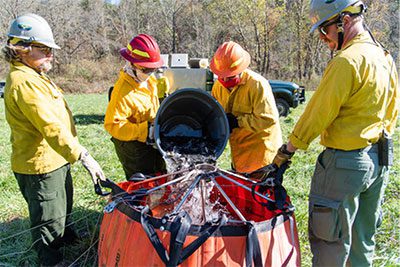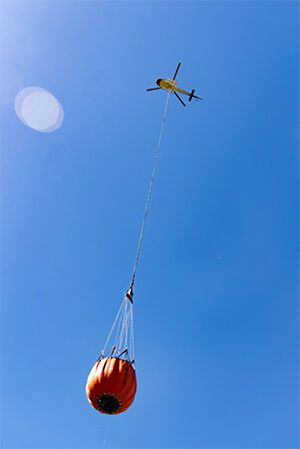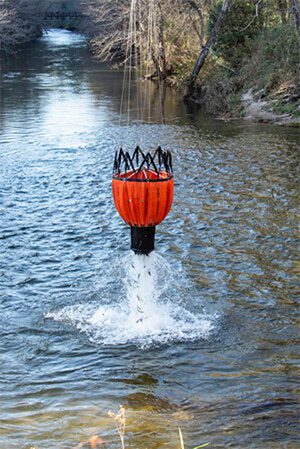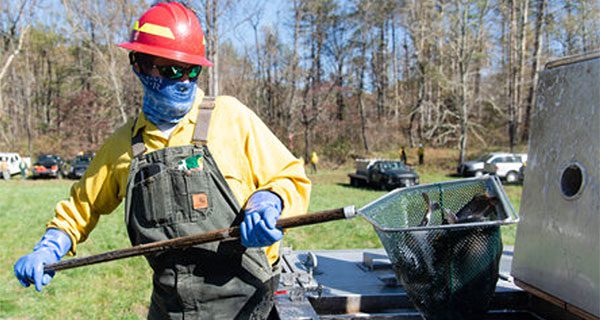A long-time conservation partnership keeps remote parts of the Chattooga River in South Carolina’s beautiful Upstate region a place where trout anglers return to time and again.
Watching an experienced team of fisheries biologists and volunteers work with a helicopter pilot to fill and drop brailer bags of trout in a remote river is a little bit like experiencing a ballet — lots of moving parts have to come together with just the right timing to make it all work.
Chattooga, Wild and Scenic River. The very words conjure up all sorts of images. If you have done a bit of whitewater paddling in the region, the Chattooga’s roaring sound pouring over and around boulders is sweet music to your ears. It is one of the longest and most spectacular free-flowing mountain rivers in the Southeast, cascading some 50 miles from its headwaters in North Carolina to the state line between South Carolina and Georgia.
But if you are a fly fisherman, or fisherwoman, or, heck, fly ANGLER, then you know the upper reaches of the Chattooga River as something special, particularly in the State of South Carolina, where we are not as blessed with trout waters as our neighboring states of Georgia and North Carolina. For it is a place where an angler can get lost in thought, lost in the music and rhythms of a river that is truly Wild and Scenic, like no other in the Palmetto State.

And thanks to an amazing partnership between the South Carolina Department of Natural Resources (SCDNR), the Georgia Department of Natural Resources, the U.S. Forest Service, and Trout Unlimited, large numbers of rainbow, brook and brown trout are stocked in the upper portions of the Chattooga River once a year, a helicopter gently laying them in backcountry areas too remote to easily be reached by vehicle. On Nov. 2, an 11-mile backcountry reach of the Chattooga River was stocked.
The Chattooga, which for a good distance forms the border between South Carolina and Georgia, was the United States’ first Wild and Scenic River, designated as such in 1974. The Wild and Scenic designation resulted in the closure of most of the access roads used for trout stocking in this 11-mile section, and that’s the reason the helicopter stocking effort started.
The first helicopter trout stockings of this part of the Chattooga began about 50 years ago, and this program has been refined considerably over time. The Chauga River in Oconee was similarly stocked with trout by helicopter on the next day, Nov. 3.

The trout fishery in this 11-mile segment of the Chattooga River is largely supported by stocking hatchery trout reared by SCDNR at Walhalla State Fish Hatchery, and by Georgia DNR at Burton State Hatchery.
These partner agencies and organizations—SCDNR, U.S. Forest Service, Georgia DNR and Trout Unlimited–have worked together as the “Chattooga River Fisheries Coalition” since 1986 to improve the trout fishery.
“We are stocking two different ‘management units’ of the Chattooga River by helicopter,” said Rankin. “One two-and-a-half-mile reach is the ‘Delayed Harvest’ area, and the eight-and-a-half-mile upper reach of the ‘Rock Gorge/Big Bend’ area has different regulations from the Delayed Harvest Area.”
Delayed Harvest, according to Rankin, is a “fish-for-fun” reach where catch-and-release with single-hook artificial lures is required Nov. 1–May 14 of each year. This stretch reverts to general fishing regulations (5 trout daily limit, no tackle restrictions) from May 15-Oct. 31. The helicopter stocked about 2,500 adult trout (10-plus inches) of rainbow, brown, and brook trout in this section.
The Rock Gorge section of the Chattooga River, which is considered a backcountry area, has no tackle restrictions and a 5-trout daily limit year-round. During the Nov. 2 helicopter stocking, SCDNR stocked 15,000 sub-adult (6-inch) brown trout and 1,000 adult brown trout (10-plus inch) in this segment. Georgia DNR will helicopter stock about 10,000 rainbow trout at a later date.
“The idea,” Rankin said, “is that some of these smaller brown trout, and then later the rainbow trout from Georgia DNR, will survive next summer and grow out to a nice size for anglers.”

Watching the gathering of equipment at Russell Bottoms, alongside SC 28 just before the bridge that leads to Georgia, is quite a spectacle. Dozens of trucks are lined up in a row, with people alternately running helter-skelter around the field (when the helicopter sets down the “Bambi Bucket,” to be filled with trout) and then standing around for long chunks of time while the chopper delivers its load to a remote section of the Chattooga River. Scenes like this are likely the genesis of the phrase “Hurry Up And Wait,” which is so appropriate for any gathering of government employees, whether it be fisheries biologists or infantry soldiers.
Completing the scene is that everyone is wearing many articles of Personal Protective Equipment (PPE), which includes a hard hat, eye protection, face coverings/masks, closed-toe shoes (leather boots preferable), gloves, and green and yellow fire-resistant Nomex pants and shirts.
The Forest Service is very diligent about PPE, not surprisingly, since being in close proximity to a helicopter is dangerous work. There is zero cell coverage at the site, which makes coordination a real challenge.
The helicopter was already on the scene when SCDNR videographer/photographer Taylor Main and I arrived around 8:20 a.m. Keith Whalen, Forest Service fisheries biologist, got Taylor suited up in all the appropriate PPE, and after the safety briefing (mandatory if you are going to get near the helicopter while the fish are being loaded), Taylor began what would be many hours of photography and videography. Over and over, she captured SCDNR Freshwater Fisheries staff netting trout from the hatchery truck into two 50-gallon plastic buckets, then carrying them to the helicopter’s “Bambi Bucket,” which was at the end of a 150-foot line. The bucket was already “watered,” and SCDNR staff poured the trout into the bucket, the chopper lifted off, and away it went.
The trout are bound for the Wild and Scenic Chattooga River, the river that runs through South Carolina and Georgia, and the anglers who will pursue them.

